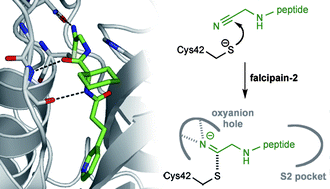Peptidomimeticnitriles as selective inhibitors for the malarial cysteine protease falcipain-2†
Abstract
Proteases of protozoan parasites have emerged as promising targets in

* Corresponding authors
a
Laboratory of Organic Chemistry, ETH Zürich, Wolfgang-Pauli-Strasse 10, Zürich, Switzerland
E-mail:
diederich@org.chem.ethz.ch
Fax: (+41)44-632-1109
b Institute of Pharmacy and Food Chemistry, University of Würzburg, Am Hubland, Würzburg, Germany
c School of Pharmacy, East China University of Science and Technology, 130 Meilong Road, Shanghai, China
Proteases of protozoan parasites have emerged as promising targets in

 Please wait while we load your content...
Something went wrong. Try again?
Please wait while we load your content...
Something went wrong. Try again?
V. Ehmke, F. Kilchmann, C. Heindl, K. Cui, J. Huang, T. Schirmeister and F. Diederich, Med. Chem. Commun., 2011, 2, 800 DOI: 10.1039/C1MD00115A
To request permission to reproduce material from this article, please go to the Copyright Clearance Center request page.
If you are an author contributing to an RSC publication, you do not need to request permission provided correct acknowledgement is given.
If you are the author of this article, you do not need to request permission to reproduce figures and diagrams provided correct acknowledgement is given. If you want to reproduce the whole article in a third-party publication (excluding your thesis/dissertation for which permission is not required) please go to the Copyright Clearance Center request page.
Read more about how to correctly acknowledge RSC content.
 Fetching data from CrossRef.
Fetching data from CrossRef.
This may take some time to load.
Loading related content
